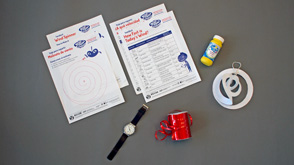Wild Wind
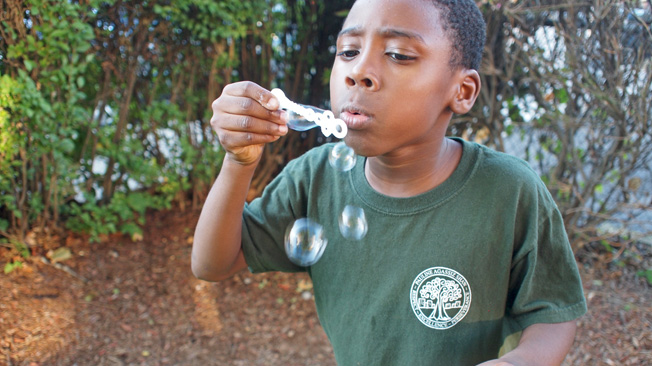
What Is This Activity?
How does wind flow through a city or town? Kids use bubbles to observe wind speed and direction, and test how buildings and streets affect wind flow.
Introduction
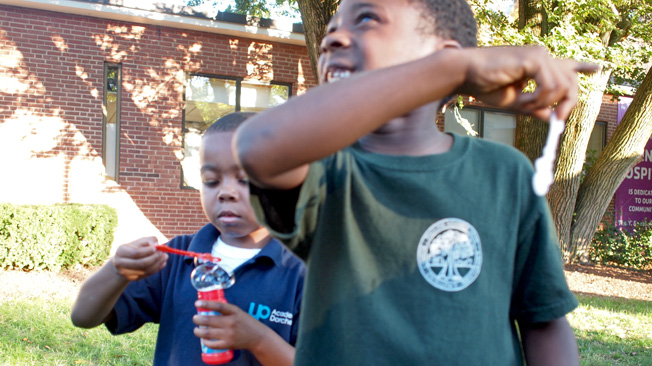
Learning Goals
Big Science Idea:
- City and town structures change the direction and speed of wind.
Skills kids will use to investigate the idea:
- Observe, compare, predict, measure, and model the impact of wind on objects
- Use observations and data to make a decision (about where and how best to hold a wind race for bubbles)
- Observe and communicate how city and town structures block wind, channel it, or create drafts
How Do You Get Ready?
- Read the activity and gather the materials.
- Buy spiral Wind Spinners at a toy store or dollar store, or make your own following the directions on the "Wind Spinner" handout. Time permitting, kids could use the handout to make Wind Spinners at the start of the "Windy City" activity.
- Scout out a suitable park, schoolyard, basketball court or other open area.
- Troubleshoot any safety concerns (traffic, poison ivy, sharp objects, etc.).
- Mark off a distance of 10 meters (about 30 yards) in your outdoor space (for the warm-up) with the two ribbons.
- If you don't plan to show "The Manta Ray Mystery" video that is paired with this activity, watch it ahead of time and jot down concepts to share with kids during the activity.
Warm-up 10-15 minutes
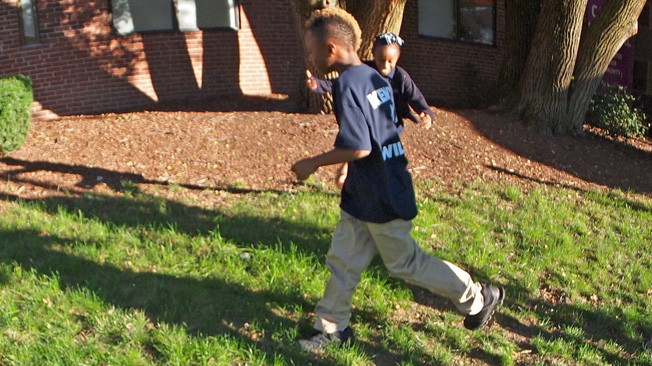
(Science Skills: Observe, measure, model, and discuss the impact of wind on objects)
- Run Like the Wind. Gather outside and discuss: How windy is it today? Wind is invisible. How do you know? Ask kids to copy your actions as you slowly turn around in place. Can you feel wind on your face? Can you tell which direction it is blowing? How forceful (or pushy) is it? How fast is it blowing? How could you measure its speed?
- Encourage kids to search for and point out the impact of wind flow on objects— moving leaves, swaying branches, a waving flag, rattling street signs, blowing hair, swirling dust or papers, etc. Wonder aloud: What if today's wind were blowing faster? And faster! What could wind do at its top speed?
- For older or more mature children: Ask them what they think is the fastest speed that wind can travel in miles per hour. You will revisit their responses below.
- Discuss wind speed: Can you run faster than the wind can blow? Can an Olympic sprinter (fast runner)?
- Time kids as they race the 10-meter distance you marked. Give them a running start to get up to full speed before reaching the start line. Optional: Time the group again, this time running in the opposite direction to see if wind affects their speed.
- Explain that the world's fastest runners cover that distance in less than one second! How do kids' times compare? (Half the speed, two seconds, would be an excellent time.) Tell the kids that record holders run nearly 28 miles per hour, but the wind can blow much, much faster!
- Hand out the "How Fast Is Today's Wind?" handout. (If you have kids who can't read well, review the art on the handout or read aloud the options for them to choose from, including the correct one. Have them make educated guesses that they explain, then provide the correct response.)
- Ask: What kind of wind blows 28 mph? (Strong breeze.) Have the kids model a strong wind. How might strong wind affect tall buildings? (Makes them sway slightly.) What can a "strong breeze" do to a tree? (Move large branches.)
- Wonder aloud: How fast can wind blow? Is there a "top speed"? What kind of damage could a super-fast wind do? Revisit kids' speed predictions, if you did the Warm-Up. (Tornadoes generate the fastest measured wind speeds, at just over 300 miles per hour, and can lift trains off their tracks.) Have kids spin like a tornado.
- Encourage kids to take the chart home and use it, with an adult's help, to estimate daily wind speed.
- Ask older or more mature children: Can you make an estimate of the wind speed for today? How could you check your guess? (Answers could vary if it's gusty or the area is blocked by wind.)
Activity 30-35 minutes
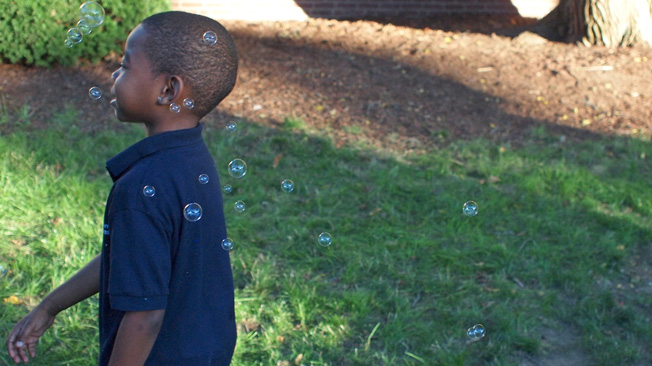
Follow the Wind
(10-15 minutes)
(Science Skills: Predict, observe and compare wind speed and direction and use observations to make a decision)
- Hand out bubbles to each kid.
- Ask the kids to predict: How far and in what direction will bubbles travel? They should give reasons for their predictions, such as, "There's almost no wind, so the bubbles won't go far."
- Give kids five to 10 minutes to spread out and openly explore how and where wind carries the bubbles. They should blow some downwind, upwind, crosswind, straight up, and any other way they can think of! Then just let the bubbles drift. Tell them not to pop the bubbles—the point is to see where they go!
- As they explore, ask: Are some areas windier than others? Is wind blowing in the same direction everywhere? How do trees, buildings, and other objects change wind flow?
- Pair up the kids. Use this experience for pairs to discuss and decide: Where is a good spot to start a bubble contest—a place where the wind will make the bubbles travel the farthest?
- Hold the contest: One kid in each pair lines up at the starting spot and blows bubbles. Their partner runs alongside the bubbles and stands where they land or pop.
- Whose bubbles traveled farthest? The winner is the pair that is farthest apart.
- Play again. Ask: Is there a better starting place with a stronger wind? Have pairs decide on a new starting spot, then switch roles and repeat the bubble race. Repeat as many times as desired and time allows. For older or more mature children: Add tougher contest challenges such as landing a bubble on a target spot by choosing a strategic launch point and then waving their arms and blowing a bubble to steer it.
- Discuss: Did all the bubbles travel in the same direction? Why or why not? (Wind can be steady or gusty; it can also change direction.) If you can't see wind, how could you measure its speed? (By watching the objects it moves.) Are the bubbles traveling slower, faster, or at the same speed as the wind? (Same speed.)
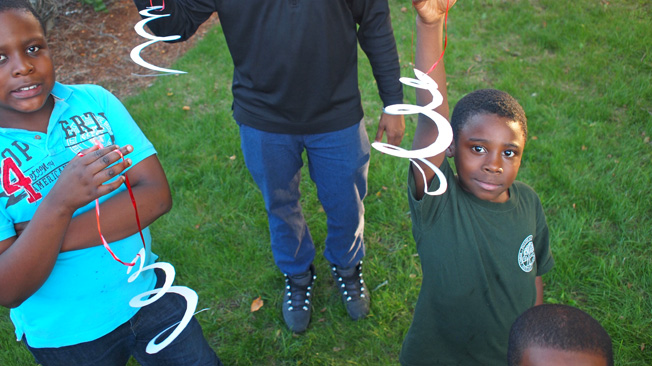
Windy City
(20 minutes)
(Science Skills: Observe how city and town structures change wind flow)
- Ask kids to share their experiences of wind in a city or town. What's the strongest wind they have felt? Where were they? Has anyone seen vortices—dust, paper, or fallen leaves blowing in a circle on the street or beside a building? What happens when you walk around the corner of a building on a windy day? (The wind can change from calm to very gusty or vice versa.)
- Explain that buildings block the wind, but they can also channel it— make it flow faster—down a narrow street. Kids might have observed this change in speed in a stream or river, where narrow parts move faster and wider parts move slower.
- Discuss: Have kids seen paper or leaves rise between tall buildings on a hot day? What might cause that? Explain that an updraft causes it. Updrafts happen when a narrow street and buildings heat up; the hot air rises rapidly. A downdraft is cooler air that is falling.
- Demonstrate how to use the Wind Spinner. Have kids look at the spinner from above. Ask: Which way is it twirling? If clockwise (to the right), the air is rising; if counterclockwise, it is falling.
- Pass out Wind Spinners and encourage kids to search for updrafts and downdrafts near buildings and water fountains, over hot pavement, in shadowed areas, etc.
Wrap-up 5 minutes
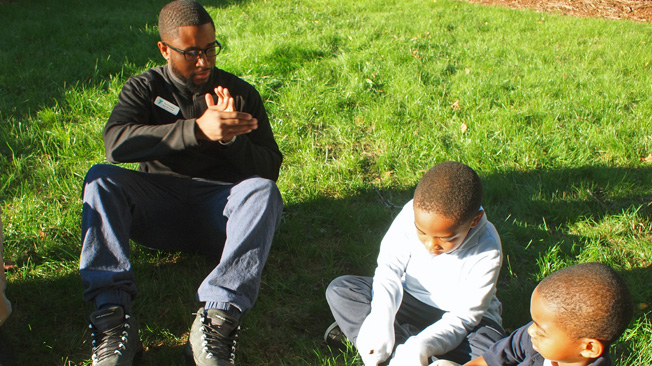
(Science Skills: Communicate information about the effects of wind on objects and of objects on wind)
- Discuss: Did anything surprise you today?
- Ask: What are ways that buildings affect wind flow in a city? (Block it, channel it, create updrafts, create vortices as wind passes near them.)
- If you haven't already, send home the "Explore Weather Around You" handout to provide families with ideas on how to continue investigating weather together.
Explore Some More
Windy Ways
Tornadoes, hurricanes, and storm winds can cause major damage to homes and other buildings. Have kids explore the relationship between wind speed and wind power with a modified bowling-type game. Set up a series of wooden pins or empty plastic bottles. Have kids roll a ball, gently at first, then at greater speeds, toward the pins. What happens as you increase the speed of the ball? How does this relate to the speed of wind?
DIY Wind Scale (Beaufort)
Challenge kids to come up with a "Wind Feel Scale" from 1 to 10. For example, a "1" could mean you feel no wind at all, a "2" could mean a soft touch on your skin, a "3" could mean your hair moves, and so on. How would kids describe the strongest winds on the scale?
Explorer's Notebook
Use the template provided: Give kids a few minutes to explore your outdoor space, drawing and writing about the wind. Guiding questions: How could you tell if the wind was blowing? Did the wind feel different in different location?

